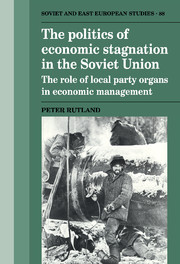 The Politics of Economic Stagnation in the Soviet Union
The Politics of Economic Stagnation in the Soviet Union Published online by Cambridge University Press: 06 July 2010
This chapter examines three areas of routine industrial activity where party organs showed a high level of involvement – the problem areas of supply procurement, quality control and conservation. Taken together, these three areas accounted for the vast bulk of routine party interventions in industrial decision-making.
All three types of activity were interrelated in that they were all responses to the entrenched tendency of the planned economy to run on the basis of the maximum achievement of quantitative plan targets. The tension which planners imposed on factories meant that the slightest perturbation in performance could cause breakdowns in the chain of supplies, and the pressure to achieve output targets meant that suppliers cut corners on quality and paid scant regard to the question of conservation.
From the 1960s onwards repeated efforts were made to expand the set of plan indicators governing managerial behaviour. These attempts proved unsuccessful, and planning by volume of production remained the standard procedure for Soviet industry. Deteriorating economic performance in the late 1970s left planners with even less room for manoeuvre. Party organs were encouraged to step into these areas of supplies and quality control, to try to break through the bureaucratic inertia of planners and managers. These political interventions into the routine functioning of Soviet industry produced some positive results at the margin, but did nothing to correct the structural flaws of the Soviet economy.
To save this book to your Kindle, first ensure [email protected] is added to your Approved Personal Document E-mail List under your Personal Document Settings on the Manage Your Content and Devices page of your Amazon account. Then enter the ‘name’ part of your Kindle email address below. Find out more about saving to your Kindle.
Note you can select to save to either the @free.kindle.com or @kindle.com variations. ‘@free.kindle.com’ emails are free but can only be saved to your device when it is connected to wi-fi. ‘@kindle.com’ emails can be delivered even when you are not connected to wi-fi, but note that service fees apply.
Find out more about the Kindle Personal Document Service.
To save content items to your account, please confirm that you agree to abide by our usage policies. If this is the first time you use this feature, you will be asked to authorise Cambridge Core to connect with your account. Find out more about saving content to Dropbox.
To save content items to your account, please confirm that you agree to abide by our usage policies. If this is the first time you use this feature, you will be asked to authorise Cambridge Core to connect with your account. Find out more about saving content to Google Drive.